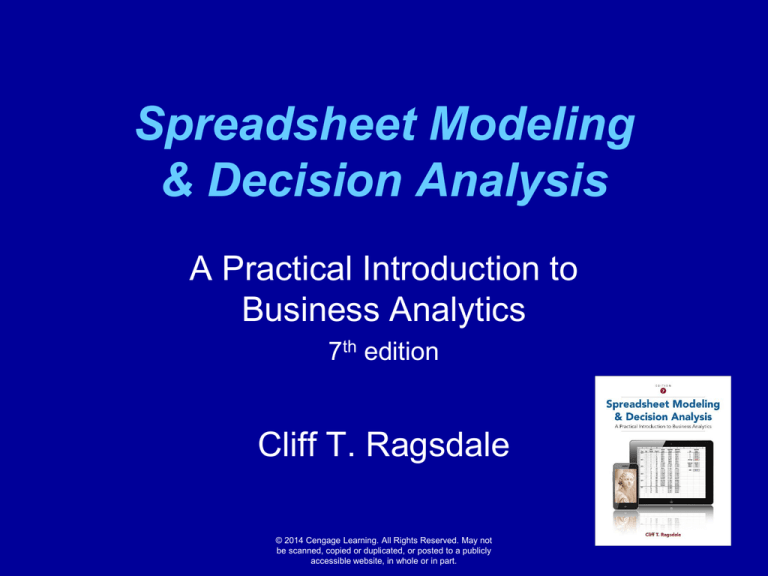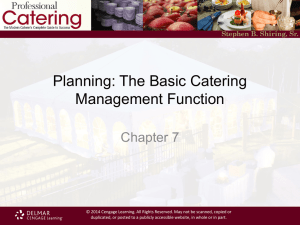
Spreadsheet Modeling
& Decision Analysis
A Practical Introduction to
Business Analytics
7th edition
Cliff T. Ragsdale
© 2014 Cengage Learning. All Rights Reserved. May not
be scanned, copied or duplicated, or posted to a publicly
accessible website, in whole or in part.
Chapter 1
Introduction to Modeling
& Problem Solving
© 2014 Cengage Learning. All Rights Reserved. May not
be scanned, copied or duplicated, or posted to a publicly
accessible website, in whole or in part.
Introduction
We face numerous decisions in life &
business.
We can use computers to analyze the
potential outcomes of decision
alternatives.
Spreadsheets are the tool of choice for
today’s managers.
© 2014 Cengage Learning. All Rights Reserved. May not
be scanned, copied or duplicated, or posted to a publicly
accessible website, in whole or in part.
What is Business Analytics?
A field of study that uses computers,
statistics, and mathematics to solve
business problems.
Also known as:
– Operations research
– Management Science
– Decision science
© 2014 Cengage Learning. All Rights Reserved. May not
be scanned, copied or duplicated, or posted to a publicly
accessible website, in whole or in part.
Home Runs
in Business Analytics
Proctor & Gamble
– Developed multi-echelon inventory
planning tool for safety stock optimization
– Lowers inventory while maintain customer
service
– Benefits:
Reduced inventory investments by $1.5 billion
© 2014 Cengage Learning. All Rights Reserved. May not
be scanned, copied or duplicated, or posted to a publicly
accessible website, in whole or in part.
Home Runs
in Business Analytics
New Brunswick (CA) Dep’t of Transportation
– Developed linear programming-based strategic
planning tool
– Includes long-term objectives and operational
constraints on costs, timings, asset life cycle
– Benefits:
Estimated $72 million in annual savings from a $2
million investment
© 2014 Cengage Learning. All Rights Reserved. May not
be scanned, copied or duplicated, or posted to a publicly
accessible website, in whole or in part.
Home Runs
in Business Analytics
Industrial and Commercial Bank of China
– World’s largest publicly traded bank
– 16,000 branch locations
– Worked with IBM to develop a tool to predict
where new branches should be opened
– Implemented in 40 cities throughout China
– Benefits:
Estimated $1 billion in new deposits in typical
major cities
© 2014 Cengage Learning. All Rights Reserved. May not
be scanned, copied or duplicated, or posted to a publicly
accessible website, in whole or in part.
Home Runs in
Business Analytics
Midwest Independent Transmission
System Operator (MISO)
– Manages power generation in 13 U.S.
midwest states
– Uses optimization model to determine when
various plants should be running
– Other models predict energy output & prices
– Benefits:
Improved plant efficiency & grid reliability
Savings of ~$3 billion from 2007-2010
© 2014 Cengage Learning. All Rights Reserved. May not
be scanned, copied or duplicated, or posted to a publicly
accessible website, in whole or in part.
What is a “Computer Model”?
A set of mathematical relationships and
logical assumptions implemented in a
computer as an abstract representation of
a real-world object of phenomenon.
Spreadsheets provide the most convenient
way for business people to build computer
models.
© 2014 Cengage Learning. All Rights Reserved. May not
be scanned, copied or duplicated, or posted to a publicly
accessible website, in whole or in part.
The Modeling Approach
to Decision Making
Everyone uses models to make
decisions.
Types of models:
– Mental (arranging furniture)
– Visual (blueprints, road maps)
– Physical/Scale (aerodynamics, buildings)
– Mathematical (what we’ll be studying)
© 2014 Cengage Learning. All Rights Reserved. May not
be scanned, copied or duplicated, or posted to a publicly
accessible website, in whole or in part.
Characteristics of Models
Models are usually simplified versions of
the things they represent
A valid model accurately represents the
relevant characteristics of the object or
decision being studied
© 2014 Cengage Learning. All Rights Reserved. May not
be scanned, copied or duplicated, or posted to a publicly
accessible website, in whole or in part.
Benefits of Modeling
Economy - It is often less costly to
analyze decision problems using
models.
Timeliness - Models often deliver
needed information more quickly than
their real-world counterparts.
Feasibility - Models can be used to do
things that would be impossible.
Models give us insight & understanding
that improves decision making.
© 2014 Cengage Learning. All Rights Reserved. May not
be scanned, copied or duplicated, or posted to a publicly
accessible website, in whole or in part.
Example of a Mathematical Model
Profit = Revenue - Expenses
or
Profit = f(Revenue, Expenses)
or
Y = f(X1, X2)
© 2014 Cengage Learning. All Rights Reserved. May not
be scanned, copied or duplicated, or posted to a publicly
accessible website, in whole or in part.
A Generic Mathematical Model
Y = f (X1, X2, …, Xn)
Where:
Y = dependent variable
(aka bottom-line performance measure)
Xi = independent variables (inputs having an impact on Y)
f (.) = function defining the relationship between the Xi & Y
© 2014 Cengage Learning. All Rights Reserved. May not
be scanned, copied or duplicated, or posted to a publicly
accessible website, in whole or in part.
Mathematical Models & Spreadsheets
Most spreadsheet models are very similar
to our generic mathematical model:
Y = f(X1, X2, …, Xn)
Most spreadsheets have input cells
(representing Xi) to which mathematical
functions, f (.) , are applied to compute a
bottom-line performance measure (or Y).
© 2014 Cengage Learning. All Rights Reserved. May not
be scanned, copied or duplicated, or posted to a publicly
accessible website, in whole or in part.
Categories of Mathematical Models
Model
Category
Prescriptive
Form of f(.)
Independent
Variables
OR/MS
Techniques
known,
well-defined
known or under
decision maker’s
control
LP, Networks, IP,
CPM, EOQ, NLP,
GP, MOLP
Predictive
unknown,
ill-defined
known or under
decision maker’s
control
Regression Analysis,
Time Series Analysis,
Discriminant Analysis,
Neural Networks,
Affinity Analysis, etc.
Descriptive
known,
well-defined
unknown or
uncertain
Simulation, PERT,
Queueing,
Inventory Models
© 2014 Cengage Learning. All Rights Reserved. May not
be scanned, copied or duplicated, or posted to a publicly
accessible website, in whole or in part.
The Problem-Solving Framework for
Leveraging Business Opportunities
Identify
Problem
“Probortunity”
Formulate &
Implement
Model
Analyze
Model
Test
Results
unsatisfactory
results
© 2014 Cengage Learning. All Rights Reserved. May not
be scanned, copied or duplicated, or posted to a publicly
accessible website, in whole or in part.
Implement
Solution
The Psychology of Decision Making
Models can be used for structurable
aspects of decision problems.
Other aspects cannot be structured
easily, requiring intuition and judgment.
Caution: Human judgment and intuition
is not always rational!
© 2014 Cengage Learning. All Rights Reserved. May not
be scanned, copied or duplicated, or posted to a publicly
accessible website, in whole or in part.
Anchoring Effects
Arise when trivial factors influence initial
thinking about a problem.
Decision-makers usually under-adjust
from their initial “anchor”.
Example:
– What is 1x2x3x4x5x6x7x8 ?
– What is 8x7x6x5x4x3x2x1 ?
© 2014 Cengage Learning. All Rights Reserved. May not
be scanned, copied or duplicated, or posted to a publicly
accessible website, in whole or in part.
Framing Effects
Refers to how decision-makers view a
problem from a win-loss perspective.
The way a problem is framed often
influences choices in irrational ways…
Suppose you’ve been given $1000 and
must choose between:
– A. Receive $500 more immediately
– B. Flip a coin and receive $1000 more if heads
occurs or $0 more if tails occurs
© 2014 Cengage Learning. All Rights Reserved. May not
be scanned, copied or duplicated, or posted to a publicly
accessible website, in whole or in part.
Framing Effects (Example)
Now suppose you’ve been given $2000
and must choose between:
– A. Give back $500 immediately
– B. Flip a coin and give back $0 if heads occurs
or give back $1000 if tails occurs
© 2014 Cengage Learning. All Rights Reserved. May not
be scanned, copied or duplicated, or posted to a publicly
accessible website, in whole or in part.
A Decision Tree for Both Examples
Payoffs
$1,500
Alternative A
Initial state
Heads (50%)
Alternative B
(Flip coin)
Tails (50%)
© 2014 Cengage Learning. All Rights Reserved. May not
be scanned, copied or duplicated, or posted to a publicly
accessible website, in whole or in part.
$2,000
$1,000
Good Decisions vs. Good Outcomes
Good decisions do not always lead to good
outcomes...
A structured, modeling approach to
decision making helps us make good
decisions, but can’t guarantee good
outcomes.
© 2014 Cengage Learning. All Rights Reserved. May not
be scanned, copied or duplicated, or posted to a publicly
accessible website, in whole or in part.
Decisions & Outcomes
Outcome Quality
Decision
Quality
Good
Bad
Good
Deserved Success
Bad Luck
Bad
Dumb Luck
Poetic Justice
© 2014 Cengage Learning. All Rights Reserved. May not
be scanned, copied or duplicated, or posted to a publicly
accessible website, in whole or in part.
End of Chapter 1
© 2014 Cengage Learning. All Rights Reserved. May not
be scanned, copied or duplicated, or posted to a publicly
accessible website, in whole or in part.
The Analytic Solver Platform
software featured in this book is
provided by Frontline Systems.
http://www.solver.com
© 2014 Cengage Learning. All Rights Reserved. May not
be scanned, copied or duplicated, or posted to a publicly
accessible website, in whole or in part.








